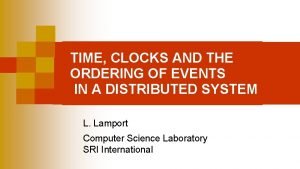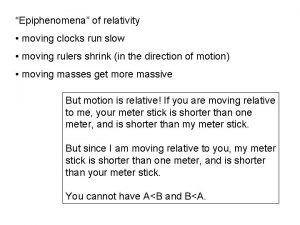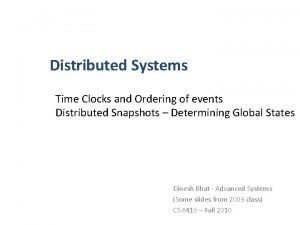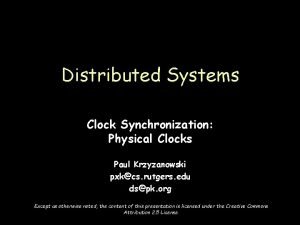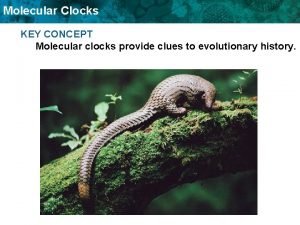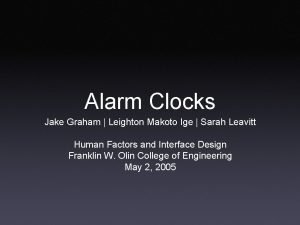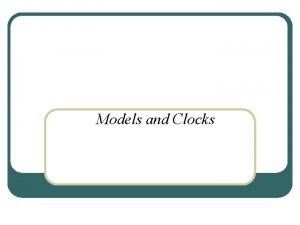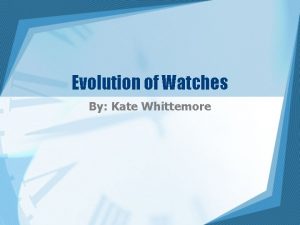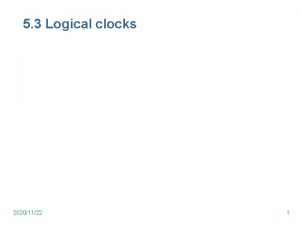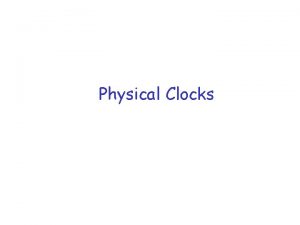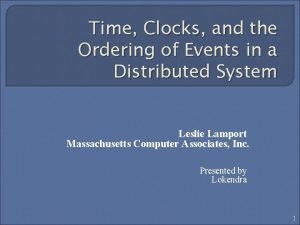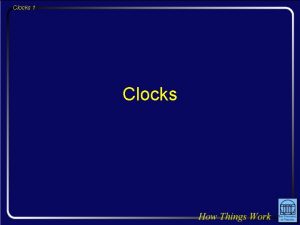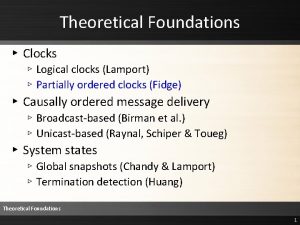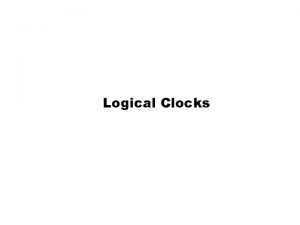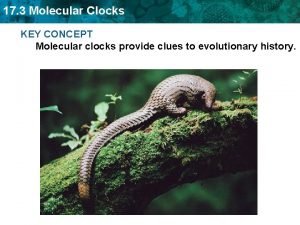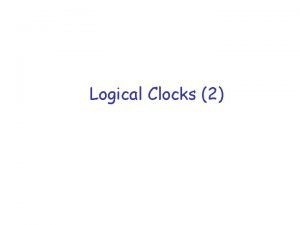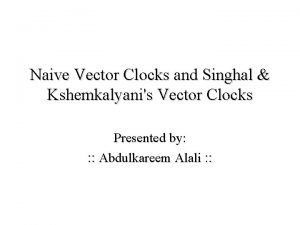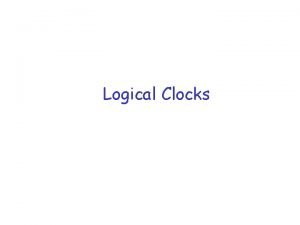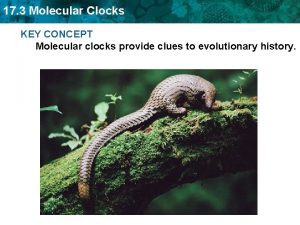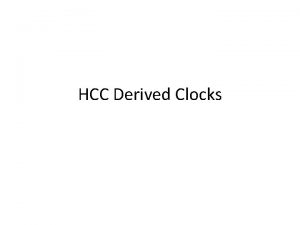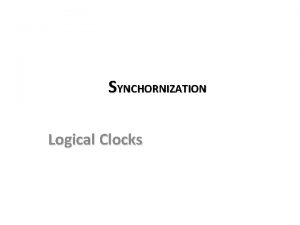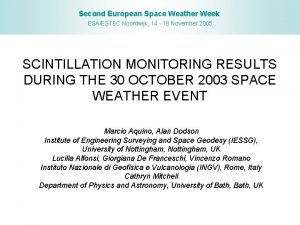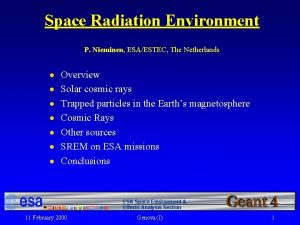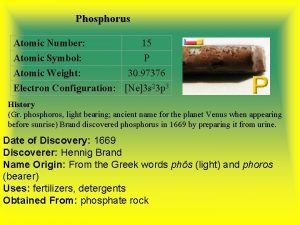Atomic Clocks in Space L Cacciapuoti ESAESTEC SCISP



























- Slides: 27

Atomic Clocks in Space L. Cacciapuoti ESA-ESTEC (SCI-SP) Frascati, 20 -22 March 2006

Atomic Clocks: Basic Principles Local oscillator Clock output Correction Atomic sample Inaccuracy: e Fractional frequency fluctuations: y(t) Fractional frequency instability: Fluctuations of the transition probability: Atomic quality factor: Frascati, 20 -22 March 2006 Transition probability Interrogation Detuning

Atomic Fountain Clocks Cs-Rb fountain clock FO 2 Nat ~ 109 s ~ 3 mm T ~ 1 K v ~ 4 m/s H~1 m 100 ms ≤ Tload ≤ 500 ms 1. 1 s ≤ Tcycle ≤ 1. 5 s Frascati, 20 -22 March 2006

Frascati, 20 -22 March 2006

Ramsey Fringes Linewidth: 0. 94 Hz Quality factor: Qat= 9. 82 109 S/N ratio: 1/sd. P ~ 5000 Frascati, 20 -22 March 2006

Performances of FO 2 Fractional frequency instability Inaccuracy ( 10 -16) Second Order Zeeman 3207. 0(4. 7) Blackbody radiation -127. 0(2. 1) Cold collisions + cavity pulling 0. 0(1. 0) Residual first order Doppler 0. 0(2. 0) Recoil 0. 0(1. 0) Ramsey and Rabi pulling 0. 0(1. 0) Microwave leakage 0. 0(2. 0) Background collisions 0. 0(1. 0) Total Frascati, 20 -22 March 2006 7

Atomic Fountain Clocks in Space Benefits from Space • Weightlessness Thermal beam – Long interrogation times – Narrow clock transitions • Linewidth: • Instability: • Accuracy: 100 m. Hz 7 10 -14 at 1 s 3 10 -16 at 1 day ~ 10 -16 • Low mechanical vibrations • Possibility of worldwide access Frascati, 20 -22 March 2006 Cold atoms in microgravity

The Frascati, 20 -22 March 2006 Mission

The ACES Payload MWL Ku- and S-band antennas PDU FCDP MWL PHARAO UGB Heat pipes XPLC SHM CU and PSU SHM RFU CEPA ACES base-plate SHM cavity assembly SHM HDA PHARAO tube PHARAO laser source Frascati, 20 -22 March 2006 PHARAO accelerometer and coils control unit Volume: 1172 x 867 x 1246 mm 3 Total mass: 227 kg Power: 450 W

PHARAO: A Cold-Atom Clock in -gravity Frascati, 20 -22 March 2006

PHARAO Optical System Detection system – Standing wave (F=4) – Pushing beam (F=4) – Pumping beam (F=3) – Standing wave (F=4) Power of the cooling laser at the fibers output – Capture 3 x 14 m. W + 3 x 12 m. W – Relative phase noise between the 6 cooling beams: ~0. 25 mrad rms (100 Hz - 100 k. Hz) Frascati, 20 -22 March 2006

SHM: An Active Maser for Space Physics Package Microwave Cavity and Shields Assembly H 2 Dissociator Low Noise Amplifier External Structure Ion Pumps High Voltage Unit Power Supply Unit Electronic Package Frascati, 20 -22 March 2006 Control Unit RF Unit Hydrogen Distribution. Assembly Dissociator Power Amplifier

SHM Physics Package Frascati, 20 -22 March 2006

SHM Parameters Measured Parameters • Temperature stabilization of the microwave cavity: <1 m. K • Active oscillation: power level of -104 d. Bm (specified: -105 d. Bm) • Measurement of the atomic quality factor via the cavity pulling effect: 1. 5 109 (specified: 1. 5 109) • Cavity quality factor: (35487 ± 164) Hz • Measurement of the spin-exchange tuning point: 8741 Hz • Characterization of the maser signal vs Bfield • Frequency instability without ACT as expected • Magnetic shielding factor: 2 105 Frascati, 20 -22 March 2006

The ACES Clock Signal Short term servo loop Locks PHARAO local oscillator to SHM ensuring a better short and midterm stability Long term servo loop Corrects for SHM drifts providing the ACES clock signal with the long-term stability and accuracy PHARAO Stability of the ACES clock signal: - 3 10 -15 at 300 s (ISS pass) - 3 10 -16 at 1 day - 1 10 -16 at 10 days Accuracy: ~1 10 -16 Frascati, 20 -22 March 2006

FCDP Engineering Model Frascati, 20 -22 March 2006

ACES Microwave Link Time stability – 0. 3 ps over 300 s – 6 ps over 1 day – 23 ps over 10 days Clock comparisons at the 10 -17 level on an integration time of 1 day possible PHARAO 100 SHM MWL sx(t ) [ps] 10 1 0, 1 10 -1 10 0 10 1 10 2 10 3 t [s] Frascati, 20 -22 March 2006 10 4 10 5 10 6 10 7

MWL Status 100 MHz Clock I/F Antennas of the microwave link space segment tested in Compensated Compact Range (CCR) S-Tx Delay Lock Loop System Timing Frascati, 20 -22 March 2006

ACES Operational Scenario • Mission Duration: 1. 5 years up to 3 years • ISS Orbit Parameters: – Altitude: ~ 400 km – Inclination: ~ 51. 6° – Period: 90 min • Link According to Orbit Characteristics: – Link duration: up to 400 seconds – Useful ISS passes: at least one per day • MWL Ground Terminals – Located at ground clock sites – Distributed worldwide Frascati, 20 -22 March 2006 Common View Comparisons – Comparison of up to 4 ground clocks simultaneously – Uncertainty below 1 ps per ISS pass (~ 300 s) Non-Common View Comparisons: – ACES clocks as fly wheel – Uncertainty below 2 ps over 1000 s and 20 ps over 1 day

ACES Mission Objectives I ACES Mission Objectives ACES performances Scientific background and recent results Test of a new generation of space clocks Cold atoms in a microgravity environment Test of the space cold atom clock PHARAO Study of cold atom physics in microgravity. Such studies will be essential for the development of atomic quantum sensors for space applications (optical clocks, atom interferometers, atom lasers). PHARAO performances: frequency instability lower than 3∙ 10 -16 at one day and inaccuracy at the 10 -16 level. The short term frequency instability will be evaluated by direct comparison to SHM. The long term instability and the systematic frequency shifts will be measured by comparison to ultra-stable ground clocks. Frequency instability: optical clocks show better performances; their frequency instability can be one or more orders of magnitude better than PHARAO, but their accuracy is still around the 10 -15 level. Inaccuracy: at present, cesium fountain clocks are the most accurate frequency standards. 2. 1∙ 10 -15 Test of the space hydrogen maser SHM performances: frequency instability lower than at 1000 s and 1. 5∙ 10 -15 at 10000 s. The medium term frequency instability will be evaluated by direct comparison to ultra-stable ground clocks. The long term instability will be determined by the on-board comparison to PHARAO in FCDP. SHM performances are extremely competitive compared to state-of-the-art as the passive H-maser developed for GALILEO or the ground H-maser EFOS C developed by the Neuchâtel Observatory: sy (1000 s) sy (10000 s) GALILEO 3. 2∙ 10 -14 1. 0∙ 10 -14 EFOS C 2. 0∙ 10 -15 Maser Precise and accurate time and frequency transfer Test of the time and frequency link MWL Time transfer stability will be better than 0. 3 ps over one ISS pass, 7 ps over 1 day, and 23 ps over 10 days. Time and frequency comparisons between ground clocks Common view comparisons will reach an uncertainty level below 1 ps per ISS pass. Non common view comparisons will be possible at an uncertainty level of 2 ps for 1000 s 5 ps for 10000 s 20 ps for 1 day Frascati, 20 -22 March 2006 At present, no time and frequency transfer link has performances comparable with MWL. Existing T&F links Time stability (1 day) Time accuracy (1 day) Frequency accuracy (1 day) GPS-DB 2 ns 3 -10 ns 4∙ 10 -14 GPS-CV 1 ns 1 -5 ns 2∙ 10 -14 GPS-CP 0. 1 ns 1 -3 ns 2∙ 10 -15 TWSTFT 0. 1 -0. 2 ns 1 ns 2 -4∙ 10 -15

ACES Mission Objectives II ACES Mission Objectives ACES performances Scientific background and recent results Precise and accurate time and frequency transfer Absolute synchronization of ground clocks Absolute synchronization of ground clock time scales with an uncertainty of 100 ps. Contribution to atomic time scales Comparison of primary frequency standards with accuracy at the 10 -16 level. These performances will allow time and frequency transfer at an unprecedented level of stability and accuracy. The development of such links is mandatory for space experiments based on high accuracy frequency standards. Fundamental physics tests Measurement of the gravitational red shift The uncertainty on the gravitational red-shift measurement will be below 50∙ 10 -6 for an integration time corresponding to one ISS pass (~ 300 s). With PHARAO full accuracy, uncertainty will reach the 2∙ 10 -6 level. The ACES measurement of the gravitational red shift will improve existing results (Gravity Probe A experiment and measurements based on the Mössbauer effect). Space-to-ground clock comparisons at the 10 -16 level, will yield a factor 25 improvement on previous measurements. Search for a drift of the fine structure constant Time variations of the fine structure constant a ca be measured at the level of precision a -1 da / dt < 1 10 -16 year -1. The measurement requires comparisons of ground clocks operating with different atoms Crossed comparisons of clocks based on different atomic elements will impose strong constraints on the time drifts of fundamental constants improving existing results. Search for Lorentz transformation violations and test of the SME Measurements can reach a precision level of dc / c ~ 10 -10 in the search for anisotropies of the speed of light. These measurements rely on the time stability of SHM, PHARAO, MWL, and ground clocks over one ISS pass. ACES results will improve previous measurements (GPS-based measurements, Gravity Probe A experiment, measurements based on the Mössbauer effect) by a factor 10 or more. Frascati, 20 -22 March 2006

Frascati, 20 -22 March 2006

From the -wave to the optical domain • Fractional frequency instability at the quantum projection noise – 1 Hz, limited by the interaction time (effect of gravity) – Nat 106, limited by cooling and trapping techniques, collisional shift, etc. • Solution: increase 0 optical transition show a potential increase of 5 orders of magnitude – -wave fountain clocks: – Optical clocks: • Accuracy theoretical studies foresee the possibility of reaching the 10 -18 regime • Major difficulties: – Measurements of optical frequencies (frequency-comb generator) – Recoil and first order Doppler effects – Downconversion noise of the interrogation oscillator (Dick effect) Frascati, 20 -22 March 2006

Principle of Operation of Optical Clocks from S. A. Diddams et al. , Science 293, 825 (2001) Frascati, 20 -22 March 2006

Accuracy of the Atomic Time Optical clocks Microwave clocks , Ca Frascati, 20 -22 March 2006

Clocks in Space Optical clocks: ~10 -15 -1/2 instability, ~10 -18 accuracy Light clocks: ~10 -17 instability floor level T&F transfer link: not degrading space clocks performances SLR: single-shot range <1 cm Uncertainty level On ground Improvement in space Isotropy of the speed of light - PRA 71, 050101 (2005) 4 10 -10 ~104 Constancy of the speed of light - PRL 90, 060402 (2003) 7 10 -7 >103 Time dilation experiments - PRL 91, 190403 (2003) 2 10 -7 ~103 Universality of the gravitational red-shift - PRD 65, 081101 (2002) 2 10 -5 >103 Time variations of fundamental constants - PRL 90, 150801 (2003) 7 10 -16 >102 Gravitational red-shift - PRL 45, 2081 (1980) 7 10 -5 >103 Lense-Thirring effect – CQG 17, 2369 (2000) 3 10 -1 ~ 102 Gravitoelectric perigee advance - CQG 21, 2139 (2004) 3 10 -3 >10 1/r-Newton’s law at long distances- PLA 298, 315 (2002) 10 -11 >10 Local Lorentz Invariance Local Position Invariance Metric Theories of Gravity Frascati, 20 -22 March 2006

Illustration taken from: http: //perso. wanadoo. fr/alain. calloch/images/daumier. GIF Frascati, 20 -22 March 2006
 Renato cacciapuoti
Renato cacciapuoti Renato cacciapuoti
Renato cacciapuoti Guido cacciapuoti scultore
Guido cacciapuoti scultore Julia cacciapuoti
Julia cacciapuoti Guido cacciapuoti wikipedia
Guido cacciapuoti wikipedia Ancona italy
Ancona italy Chemistry periodic trends
Chemistry periodic trends Atomic number vs atomic radius
Atomic number vs atomic radius Atomic radius trends on periodic table
Atomic radius trends on periodic table Atomic weight of oxygen
Atomic weight of oxygen Relative atomic mass of beryllium
Relative atomic mass of beryllium Distinguish between mass number and atomic mass.
Distinguish between mass number and atomic mass. Time clocks and the ordering of events
Time clocks and the ordering of events Who painted the melting clocks
Who painted the melting clocks Moving clocks run slow
Moving clocks run slow Time clocks and the ordering of events
Time clocks and the ordering of events Physical clocks
Physical clocks Shang dynasty acrostic poem
Shang dynasty acrostic poem Clues clocks and keys
Clues clocks and keys Appointment clocks
Appointment clocks Graham and green clocks
Graham and green clocks Vector clock in distributed system
Vector clock in distributed system Kate whittemore
Kate whittemore Lamport's logical clocks
Lamport's logical clocks Physical clocks
Physical clocks Leslie lamport time clocks
Leslie lamport time clocks Unscented trajectory chapter 5
Unscented trajectory chapter 5 Space junk the space age began
Space junk the space age began












